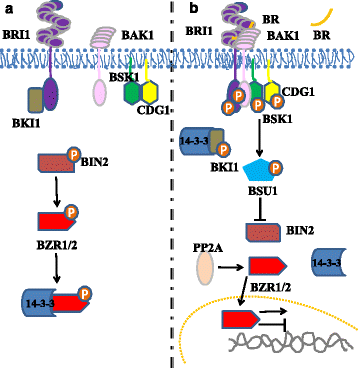Q&A: what are brassinosteroids and how do they act in plants?
- PMID: 28007032
- PMCID: PMC5180403
- DOI: 10.1186/s12915-016-0340-8
Q&A: what are brassinosteroids and how do they act in plants?
Abstract
Brassinosteroids (BRs) are a class of polyhydroxylated steroidal phytohormones in plants with similar structures to animals' steroid hormones. Brassinosteroids regulate a wide range of physiological processes including plant growth, development and immunity. Brassinosteroid signalling and its integration with other signalling pathways have been investigated thoroughly at the molecular level.
Figures



Similar articles
-
The molecular circuit of steroid signalling in plants.Essays Biochem. 2015;58:71-82. doi: 10.1042/bse0580071. Essays Biochem. 2015. PMID: 26374888 Review.
-
Brassinosteroids, the Sixth Class of Phytohormones: A Molecular View from the Discovery to Hormonal Interactions in Plant Development and Stress Adaptation.Int J Mol Sci. 2019 Jan 15;20(2):331. doi: 10.3390/ijms20020331. Int J Mol Sci. 2019. PMID: 30650539 Free PMC article. Review.
-
Balancing growth and adaptation to stress: Crosstalk between brassinosteroid and abscisic acid signaling.Plant Cell Environ. 2020 Oct;43(10):2325-2335. doi: 10.1111/pce.13846. Epub 2020 Aug 31. Plant Cell Environ. 2020. PMID: 32671865 Review.
-
Arabidopsis brassinosteroid signaling pathway.Sci STKE. 2006 Dec 5;2006(364):cm5. doi: 10.1126/stke.3642006cm5. Sci STKE. 2006. PMID: 17148786 Review.
-
Benefits of brassinosteroid crosstalk.Trends Plant Sci. 2012 Oct;17(10):594-605. doi: 10.1016/j.tplants.2012.05.012. Epub 2012 Jun 26. Trends Plant Sci. 2012. PMID: 22738940 Review.
Cited by
-
The cap-binding complex modulates ABA-responsive transcript splicing during germination in barley (Hordeum vulgare).Sci Rep. 2024 Aug 7;14(1):18278. doi: 10.1038/s41598-024-69373-9. Sci Rep. 2024. PMID: 39107424 Free PMC article.
-
Molecular Network for Regulation of Ovule Number in Plants.Int J Mol Sci. 2021 Nov 30;22(23):12965. doi: 10.3390/ijms222312965. Int J Mol Sci. 2021. PMID: 34884791 Free PMC article. Review.
-
Transport mechanisms of plant hormones.Curr Opin Plant Biol. 2021 Oct;63:102055. doi: 10.1016/j.pbi.2021.102055. Epub 2021 Jun 5. Curr Opin Plant Biol. 2021. PMID: 34102450 Free PMC article. Review.
-
Plant Hormones in Phytoplasma Infected Plants.Front Plant Sci. 2019 Apr 17;10:477. doi: 10.3389/fpls.2019.00477. eCollection 2019. Front Plant Sci. 2019. PMID: 31057582 Free PMC article. Review.
-
Therapeutic Potential of Brassinosteroids in Biomedical and Clinical Research.Biomolecules. 2020 Apr 9;10(4):572. doi: 10.3390/biom10040572. Biomolecules. 2020. PMID: 32283642 Free PMC article. Review.
References
-
- Taiz L, Zeiger E. Plant Physiol. 5. Sunderland: Sinauer Associates; 2010.
Publication types
MeSH terms
Substances
LinkOut - more resources
Full Text Sources
Other Literature Sources

